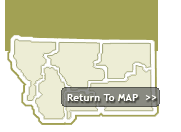

| Home | Communities | Accommodations | Places To Go | Things To Do | Site Map |
|
Glacier Country
Central Montana
Missouri River Country
Southwest Montana
Yellowstone Country
Southeast Montana
|

Sand Creek Wildlife StationRoy MontanaListing Type: Wildlife RefugeCity: Roy Montana Region: Central Montana 406-464-5181 http://www.r6.fws.gov/cmr/ |
The west end of the Charles M. Russell NWR, managed from the Sand Creek Wildlife Stations, provides a unique representation of the rugged Missouri River Breaks and adjacent sagebrush grassland. The landscape is little changed from the time that Lewis and Clark came up the valley in 1804. The Breaks (deep canyons) formed when the Missouri River was forced into a new channel by glaciers during the Ice Age. The steep, rapidly eroding canyons resulted in sites favorable for the establishment of Douglas-fir, Ponderosa pine and Rocky Mountain juniper. Plains cottonwood line the Missouri River and sagebrush grassland finger out onto the ridges between the canyons.
Mule and white-tailed deer, elk, pronghorn, coyote, bobcat, prairie dogs, raptors and grouse are common. Big horn sheep inhabit remote buttes and cliffs, and occasionally the tracks of mountain lion can be seen in the mud or snow. The rare black-footed ferret was recently reintroduced to the refuge.
Fishing is popular in the Missouri River an Fort Peck Reservoir. Hunters pursue deer, elk and grouse in the fall. Elk watching during the rut, in a 'closed' portion of the refuge, is growing in popularity, Dozens or more can be seen in early morning or at dusk, the bulls bugling their challenge to rival males. Primitive camping is allowed on nearly the entire refuge, as is hiking, bird watching and horseback riding. Solitude will reward the a,ambitious hiker, and spectacular views can be enjoyed from the ridge tops and canyon rims.
The refuge is open year round, but mostly unimproved roads make travel inadvisable during winter and after rain. For more information call (406) 464-5181 or 538-8706.
Directions: Sand Creek wildlife Station of the Charles M. Russell National wildlife Refuge is located 19 miles north of the intersection of Highways 191 and 19 (41 miles north of Glasgow). The Wildlife Station is staffed during working hours and leaflets are available at all hours in the Station entrance way.
Other activities such as hunting and fishing available .
Sand Creek Wildlife Station
Charles M. Russell National Wildlife Refuge, Roy, MT 59471
|
A source for Montana Travel & Tourism Information
![]()